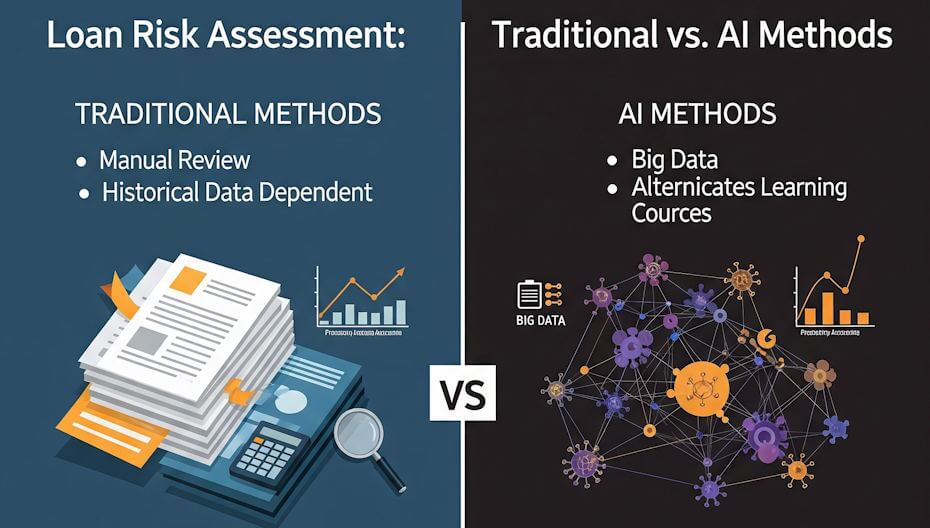How AI is Transforming Loan Risk Assessment
In the past, assessing the risk of a loan largely depended on manual evaluations and credit history checks. Banks and financial institutions relied heavily on traditional models, often prone to biases and inefficiencies. Today, Artificial Intelligence (AI) is radically reshaping the way lenders evaluate risk, providing smarter, faster, and more accurate predictions.
The Limitations of Traditional Loan Risk Assessment
Traditional risk assessment methods have been around for decades. They typically involve analyzing a borrower’s credit score, income, employment history, and debt-to-income ratio. While these metrics offer a baseline, they often fail to capture the full picture:
- Biases: Manual evaluations can be influenced by unconscious biases, leading to unfair lending practices.
- Slow Processes: Paperwork and multiple approvals can delay decisions, frustrating customers.
- Limited Data: Only a small subset of financial behavior is considered, leaving out alternative data that could improve accuracy.
This is where AI comes into play, offering the ability to analyze vast datasets and detect patterns humans might miss.
AI in Loan Risk Assessment
Artificial Intelligence leverages machine learning, predictive analytics, and data modeling to assess risk. Instead of relying solely on a credit score, AI algorithms analyze a wide range of data, including:
- Transaction history and spending patterns
- Employment stability and career growth trends
- Social and behavioral data (where legally permissible)
- Macroeconomic indicators that could affect repayment capacity
By integrating these inputs, AI creates a more holistic view of a borrower’s risk profile, allowing lenders to make better-informed decisions. This also opens opportunities for thecreditpeople to provide guidance and personalized solutions based on AI-powered insights.
Benefits of AI-Powered Risk Assessment
Implementing AI in loan risk assessment has several tangible advantages:
- Speed: Automated systems can process applications in minutes instead of days.
- Accuracy: Advanced models detect subtle patterns that traditional methods might miss.
- Fairness: When trained responsibly, AI can reduce human biases.
- Cost Efficiency: Reduces operational costs associated with manual assessment.
Comparing Traditional vs AI-Based Assessment
| Feature | Traditional Assessment | AI-Based Assessment |
|---|---|---|
| Speed | Several days | Minutes |
| Data Sources | Credit score, income, debt | Credit data + alternative data + macroeconomic trends |
| Accuracy | Moderate | High |
| Bias | Possible | Reduced with proper model training |
| Cost | High operational cost | Lower long-term cost |
Challenges of Implementing AI
Despite the benefits, AI is not without challenges. Financial institutions must:
- Ensure data privacy and compliance with regulations.
- Maintain transparency in how AI models make decisions.
- Continuously monitor models for fairness and accuracy.
Addressing these challenges is critical. Mismanagement could lead to regulatory scrutiny or even harm consumers if AI misinterprets data.
The Future of AI in Lending
AI will continue to evolve, integrating even more sophisticated predictive analytics and real-time decision-making. The potential extends beyond just risk assessment; it includes fraud detection, dynamic interest rate pricing, and personalized financial advice. For borrowers and lenders alike, understanding these advancements is key to staying ahead in a rapidly changing financial landscape.
Ultimately, AI is helping create a more inclusive and efficient lending ecosystem. Borrowers who might have been overlooked by traditional methods now have a fairer chance of securing credit. And lenders can mitigate risk more effectively, making the entire process more sustainable.
For individuals looking to navigate this new AI-driven lending landscape, resources like thecreditpeople offer invaluable guidance, combining human expertise with technology-powered insights.
Conclusion
AI is transforming loan risk assessment by offering faster, more accurate, and fairer evaluations. While challenges remain, the benefits for both lenders and borrowers are clear. As technology continues to advance, staying informed and leveraging AI-powered tools will be crucial for anyone involved in the lending process.



